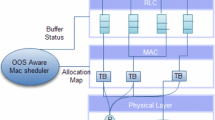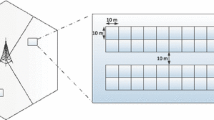Abstract
The current mobile broadband market experiences major growth in data demand and average revenue loss. To remain profitable from the perspective of a service provider (SP), one needs to maximize revenue as much as possible by making subscribers satisfied within the limited budget. On the other hand, traffic demands are moving toward supporting the wide range of heterogeneous applications with different quality of service (QoS) requirements. In this paper, we consider two related packet scheduling problems, i.e., long-term and short-term approaches in the 4th generation partnership project (3GPP) long term evolution-advanced (LTE-A) system. In the long-term approach, the long-term average revenue of SP subject to the long-term QoS constraints for heterogeneous traffic demands is optimized. The problem is first formulated as a constrained Markov decision process (CMDP) problem, of which the optimal control policy is achieved by utilizing the channel and queue information simultaneously. Subsequently, in the short-term approach, we consider the short-term revenue optimization problem which stochastically guarantees the short-term QoS for heterogeneous traffic demands through a set of chance constraints. To make the proposed chance-constrained programming problem computationally tractable, we use the Bernstein approximation technique to analytically approximate the chance constraint as a convex conservative constraint. Finally, the proposed packet scheduling schemes and solution methods are validated via numerical simulations.








Similar content being viewed by others
Notes
\({\Gamma }(a,u)={\int }_{u}^{\infty }t^{a-1}e^{-t}\text {d}t\) and \({\Gamma }(a)={\int }_{0}^{\infty }t^{a-1}e^{-t}\text {d}t\)
References
3GPP, TR 25.943, v10.0.0 (2011-04): Technical specification group radio access networks; deployment aspects (release 10) http://www.etsi.org/deliver/etsi_tr/125900_125999/125943/11.00.0060/
Altman E (1995) Constrained Markov decision processes
Andrews M, Kumaran K, Ramanan K, Stolyar A, Whiting P, Vijayakumar R (2001) Providing quality of service over a shared wireless link. IEEE, Commun Mag 39(2):150–154. doi:10.1109/35.900644
Balakrishnan R, Canberk B (2014) Traffic-aware QoS provisioning and admission control in ofdma hybrid small cells. IEEE Trans, Veh Technol 63(2):802–810. doi:10.1109/TVT.2013.2280124
Bertsekas D (1987) Dynamic Programming: Deterministic and Stochastic Models, Pearson Higher Education & Professional Group. http://books.google.com.hk/books?id=-6RiQgAACAAJ
Cui Y, Lau VKN (2010) Distributive stochastic learning for delay optimal OFDMA power and subband allocation. IEEE Transaction of Signal Procssing 58(9):4848–4858. doi:10.1109/TSP.2010.2050062
Di Renzo M, Graziosi F, Santucci F (2010) Channel capacity over generalized fading channels: A novel MGF-Based approach for performance analysis and design of wireless communication systems. IEEE Trans Veh Technol 59(1):127–149. doi:10.1109/TVT.2009.2030894
Kokku R, Mahindra R, Zhang H, Rangarajan S (2013) Cellslice: Cellular wireless resource slicing for active RAN sharing. In: Communication Systems and Networks (COMSNETS), 2013 Fifth International Conference on, pp 1–10. doi:10.1109/COMSNETS.2013.6465548
Lee SB, Choudhury S, Khoshnevis A, Xu S, Lu S (2009) Downlink MIMO with frequency-domain packet scheduling for 3GPP LTE. In: IEEE INFOCOM, pp 1269 –1277. doi:10.1109/INFCOM.2009.5062041
Nemirovski A, Shapiro A (2006) Convex approximations of chance constrained programs. SIAM J Optim 17:969–996
Niafar S, Huang Z, Tsang DHK (2014) An optimal standard-compliant MIMO scheduler for LTE downlink. IEEE Trans Wirel Commun 99:1–10. doi:10.1109/TWC.2014.012814.131600
Powell W (2007) Approximate Dynamic Programming: Solving the Curses of Dimensionality. Wiley Series in Probability and Statistics. Wiley. http://books.google.com.hk/books?id=WWWDkd65TdYC
Ruby R, Leung V (2011) Towards QoS assurance with revenue maximization of LTE uplink scheduling. In: Communication Networks and Services Research Conference (CNSR), 2011 Ninth Annual, pp 202–209. doi:10.1109/CNSR.2011.37, pp 202–209
Sesia S, Toufik I, Baker M (2011) LTE-The UMTS Long Term Evolution: From Theory to Practice. Wiley. http://books.google.com.hk/books?id=beIaPXLzYKcC
Simon M, Alouini M (2000) Digital communication over fading channels: a unified approach to performance analysis. Wiley series in telecommunications and signal processing. Wiley. http://books.google.com.hk/books?id=CvhSAAAAMAAJ
Tan C, Beaulieu N (2000) On first-order Markov modeling for the Rayleigh fading channel. IEEE Trans Commun 48(12):2032–2040. doi:10.1109/26.891214
Xu W, Tajer A, Wang X, Alshomrani S (2014) Power allocation in MISO interference channels with stochastic CSIT. IEEE Trans Wirel Commun 13(3):1716–1727. doi:10.1109/TWC.2014.012814.131600
Zhang H, Prasad N, Rangarajan S (2012) MIMO downlink scheduling in LTE systems. In: IEEE INFOCOM, pp 2936 – 2940
Author information
Authors and Affiliations
Corresponding author
Appendix
Appendix
1.1 Proof of proposition 2
To apply the Bernstein approximation for the constraint in Eq. 18, based on our commonly used assumption of backlogged traffic model we can omit the [⋅]+ operator form the constraint. In the backlogged traffic model, as the name suggests, each user has always packet to transmit. Accordingly, the inequality \(q_{i}(n)-{\sum }_{j\in \mathcal {R}}{\sum }_{m\in \mathcal {M}} r_{ij}^{m}(n)x_{ij}^{m}+a_{i}(n)>\beta _{i}\) can be equivalently expressed as
where ζ i =(r i ,a i ) and
F i (x,ζ i ) is in the form of affine chance constraint which involves linear form of the random variables ζ i =(r i ,a i ). Based on the Bernstein approximation, constraint (18) can be approximated by
where
where \({\Lambda }_{r_{ij}^{m}}\) and \({\Lambda }_{a_{i}}\) are the cumulant (log-moment) generating function of the data rate and arrival process, respectively.
In the sequel, we derive the cumulant generating function of the random variable \(r_{ij}^{m}\), which is a function of the channel gain random variable. The moment generating function (MGF) of \(r(\gamma _{ij}^{m})=W\log (1+\gamma _{ij}^{m})\), where \(\gamma _{ij}^{m}=\frac {pg_{ij}}{{\Delta }_{m} \sigma ^{2}}\), is given in [7] as follows
where Q(a,u)=Γ(a,u)/Γ(a) is the regularized Gamma functionFootnote 1 and \(M_{\gamma _{ij}^{m}}^{(1)}(\cdot )\) is the first derivative of the MGF of \(\gamma _{ij}^{m}\). \(M_{\gamma _{ij}^{m}}(\cdot )\) is known in closed-form for many fading distributions [15]. Without loss of generality, consider the channel gain as an exponentially distributed random variable with PDF given by \(f_{g_{ij}}(\xi )=\frac {1}{\mu _{i}}\exp (-\frac {\xi }{\mu _{i}})\), where μ i is the mean slow fading channel gain for user i and can be characterized based on path-loss and shadowing effects. In practice, the difference between different resource blocks is indistinguishable for slow fading channel parameter μ i . The value of μ i oughts to be updated at the beginning of each time window t. Hence, the cumulant generating function of the data rate can be achieved as
To calculate the cumulant generating function of the arrival process, e.g., \({\Lambda }_{a_{i}}\), without loss of generality consider the arrival process for the traffic of the user i follows Poisson distribution with parameter as \(f_{a_{i}}(k)=\frac {\bar {a}_{i}^{k} e^{-\bar {a}_{i}}}{k!}\), where \(\bar {a}_{i}\) represents the average rate. \({\Lambda }_{a_{i}}\) can be computed as
Rights and permissions
About this article
Cite this article
Niafar, S., Tan, X. & Tsang, D.H. Optimal Downlink Scheduling for Heterogeneous Traffic Types in LTE-A Based on MDP and Chance-Constrained Approaches. Mobile Netw Appl 21, 390–401 (2016). https://doi.org/10.1007/s11036-015-0645-9
Published:
Issue Date:
DOI: https://doi.org/10.1007/s11036-015-0645-9




